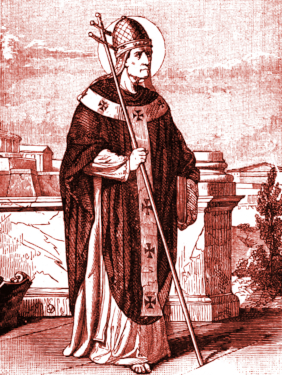Lives of the Saints
Our Models and Protectors
Spiritual Bouquet:
January 5

Saint Telesphorus
Pope and Martyr
(† 137)
By the death of Saint Sixtus(1), the first of that name, Pope, and Martyr, succeeded in Saint Peter’s Chair Saint Telesphorus, also Pope and Martyr. He was of Greece by birth and had been an anchorite(2), and for his great sanctity and high merits, two days after the death of Saint Sixtus, he was elected Chief Bishop with much applause. In his time arose many heretics and false prophets, which disturbed the Church of God, and by their wicked and dishonest lives, were a discredit to the Christian religion. As they lived lewdly, given to all vice and baseness, calling themselves Christians, the Gentiles believed that all Christians were like unto them. And that their religion gave license to live in that manner; did they despise all those who professed it, and persecuted them, judging them unworthy of living, and deserving any torment whatsoever. But our Lord was pleased that by the diligence and vigilance of Saint Telesphorus, Saint Justin, the philosopher and martyr, and other holy and learned persons, whom God raised in His good time for the protection of His Church, the truth was discovered. The heretics, with their followers, were known for wicked, and the Catholics for Good, as they were. Saint Telesphorus, in his life and conversation, was very like to those holy chief pastors, his predecessors, and as such he ought to be, who undertook so high a dignity.
He ordained before Easter that there should be a fast kept for seven weeks, and the clergy began to fast from Quinquagesima Sunday(3): and from henceforth, some have believed Telesphorus instituted the fast of Lent. But the truth is, the institution is from the Apostles. Before this bishop’s time, it was practiced in the Church of God, as gathered from Saint Ignatius and other holy and most ancient writers. He also commended that Mass should be celebrated on the night of the Nativity and that in the Mass should be said the Hymn of the Angels, Gloria in Excelsis Deo. He gave orders four times in December and then ordained twelve priests, eight deacons, and thirteen bishops.
He was martyred during the time of Antonius Pius(4), Emperor, in the year of our Lord 154. He was buried in the Vatican, near the body of Saint Peter, Prince of the Apostles, having governed the Church eleven years nine months, wanting three days. The Holy Church celebrates his Commemoration on the fifth of January, the day of his martyrdom; Pope Clement VIII commanded it to be added to the reformed Breviary, which by his order was published in 1602.
Pedro de Ribadeneyra,“The Life of Saint Telesphorus, Pope and Martyr.” The Lives of Saints, With Other Feasts of the Year, according to the Roman Calendar. Written in Spanish by the Reverend Father Peter Ribadeneyra, Priest of the Society of Jesus. Translated Into English by W.P. (William Petre) Esq; The Second Edition Corrected and Amended, vol.1, pp. 75–76. London.
Edited by Michael Murphy. Used with permission.
Consider purchasing Michael Murphy's book:
Not of Universal Importance: Canceled Saints and Lost Seasons in the Liturgical Calendar Changes of 1969
Notes:
1. Pope Sixtus I, also known as Xystus, was a Roman of Greek descent who served as bishop of Rome from around 115 until his death in 126.
2. An anchorite or anchoret is a Christian who withdraws from secular society for religious reasons in order to live an intensely prayer-oriented, ascetic, or Eucharist-focused life.